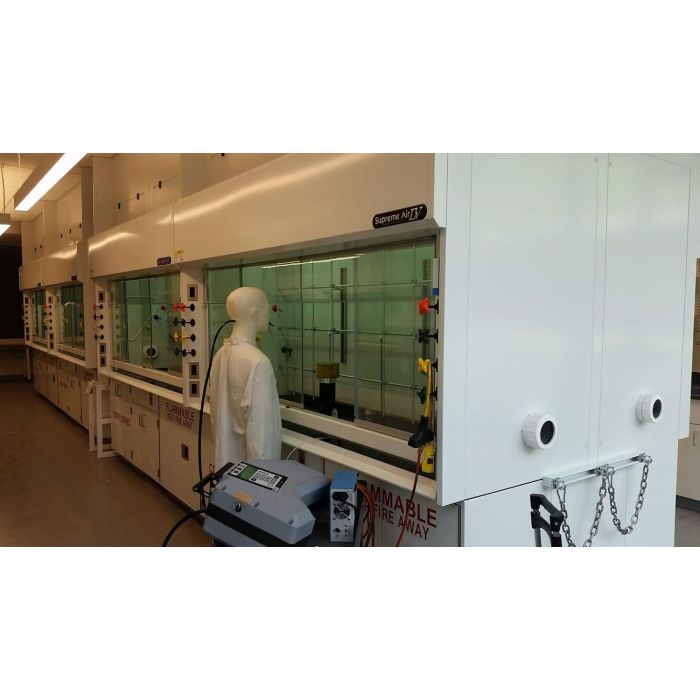ASHRAE Test
ASHRAE standard 110-2016 (commonly referred to as ASHRAE 110) provides “Methods of Testing Performance Laboratory Fume Hoods” to provide a quantitative and qualitative test method to gauge a laboratory fume hood’s level of containment.
Tracer Gas test: Face velocity had been used historically as the primary indicator of fume hood performance, however tracer gas containment test reveal that face velocity test alone is an inadequate indicator of fume hood performance. Tracer gas tests provide quantitative data evaluating the containment performance of fume hoods. Therefore, the tracer gas test is the ultimate test for the containment of a fume hood.
The test simulates a lab technician using a fume hood. Tracer gas test uses a mannequin to represent the lab technician, and a probe is placed in what would be the technicians breathing zone. The probe runs to an analyzer that logs the tracer gas concentration while testing. The tracer gas flows through an ejector at a set rate. We report the performance of the hood based on the results of the test.
Tracer Gas Testing
The tracer gas used for testing shall be sulfur hexafluoride, SF6 with 99.9% purity. Sulfur hexafluoride (SF6) is an inorganic, colorless, odorless, non-flammable, non-toxic but extremely potent greenhouse gas. It has a density of 6.12 g/L at sea level conditions, considerably 6 times heavier than the density of air (1.225 g/L), this is one of the main reason why SF6 gas is used.
The cylinder shall be capable of maintaining 30 psi at a release rate of at least 4 Lpm for 30 minutes. Normally 10 kg cylinder would be ideal for shipping to jobsites, as these gas cylinders contain gas under pressure.
However, do note that SF6 is not good for the environment due to its greenhouse effect, so a lot of places are limiting its use. Unfortunately, there is not a great substitute at this point. ASHRAE is studying new gases to determine the best one to use, but it may be years before we have a concrete alternative.
- Ejector System: The ejector for the tracer gas will follow specifications provided in the ASHRAE 110.
- Detection Instruments: The detector instrument shall be a continuous reading instrument set up for the tracer gas. A minimum detection range of 0.01 to 20 ppm is required. The instrument will be accurate to ± 10% of the reading or 0.025, whichever is greater. The instrument will can log data digitally.
- Mannequin: The mannequin shall be a three-dimensional mannequin that accurately portrays human proportions. The mannequin will be clothed in a smock, coveralls, or clothing typical to that worn in a laboratory setting.
- Tracer Gas Test Procedure
The Miran-103 is the commonly used specific gas analyzer. Recently, I found there are few other companies producing similar gas analyzers for containment testing on hood. The stepwise procedure to conduct the containment test using Miran-103 equipment are:
- The Miran-103 shall be given sufficient time to warm up and adjust to the conditions in the room.
- We shall test the functionality of the instrument using the closed-loop method before testing a hood can begin.
- For typical fume hoods with vertical rising sashes the gas ejector shall be tested in 3 unique positions. These positions, unless otherwise specified, are – 12 inches from the left sidewall, equidistant from both sidewalls, and 12 inches from the right sidewall.
- The aluminum barrel of the ejector shall be positioned 6 inches behind the sash with the bonnet extending 1 inch closer to the sash.
- The mannequin shall have a probe attached at the breathing zone. The end of this probe shall be located 6 inches from the plane of the sash, or 3 inches from the plane of the sash, and 22 inches above the plane of the worktop.
- The gas shall be turned on and given 30 seconds before recording data.
Data shall be recorded for 5 minutes with readings being taken at least every second. Using Pico Digitizer, we can monitor and record the data on the laptop/computer for documentation and reports.
After testing at every position, we record the performance rating of the hood as the highest control level recorded for all the positions.
- Sash Movement Containment Test
- The sash movement containment test shall be a 2-minute test that occurs at the end of each 5-minute Tracer Gas Test.
- The sash shall be opened and closed every 30 seconds 3 times.
- The performance rating for the sash movement effect (SME) shall be recorded as the highest control level recorded for all the positions.


